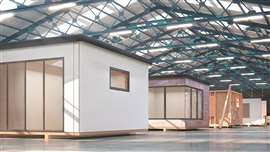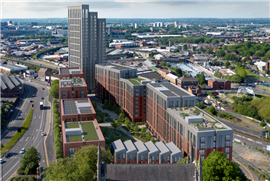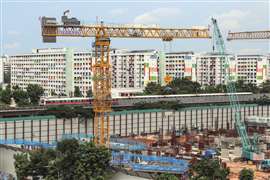What’s next for modular construction?
21 March 2024
The trend – which goes by many names – sees continued annual growth, but will modular building ever reach mass adoption? Mitchell Keller reports.
With each passing year modular construction drums up another round of speculation and interest.
 A warehouse stores modular homes. Off-site investment will be key for contractors and builders looking to enter the prefab space (Image: Adobe Stock)
A warehouse stores modular homes. Off-site investment will be key for contractors and builders looking to enter the prefab space (Image: Adobe Stock)
This year is no different, and there’s plenty of large modular builds breaking ground and opening across the globe.
For example, Birmingham, UK, is home to one of the country’s largest build-to-rent modular builds to date, the Smith’s Garden project (formerly known as Camp Hill Gardens). The project – currently in-development – received the green light in 2022 and began initial site construction in 2023.
According to prime contractor Elements Europe, a subsidy of Korea-based GS E&C, 1,143 modules will be manufactured in Telford, UK, (roughly 55km from Birmingham) from November 2023 through to January 2025.
The scheme will run on four acres with six buildings planned, ranging from three to 26 storeys. The structures will house roughly 550 flats and apartment homes, from studios to four-bedroom townhouses.
It’s a large project, and a good example of how scale and build-to-order modular construction can help turn off-site builds profitable, said James Bechely-Crundall, senior VP of Macquarie Asset Management, which provided funding for the project.
“Our investment in the project on behalf of our managed funds is aligned to our strategy of establishing and incubating specialist real estate managers in sectors we believe are supported by significant structural tailwinds,” he said in 2023 when financing was announced. “We believe that a scalable market opportunity exists in the UK rental residential sector.”
The scheme will be sustainably built with a planned 50% (or more) reduction in operational carbon and a 30% in embodied carbon (vs. current UK building regulations), much of which is obtained through the isolated manufacturing process.
 A rendering of Smith’s Garden residential build-to-rent modular project in Birmingham, UK (Image: ELEMENT EUROPE)
A rendering of Smith’s Garden residential build-to-rent modular project in Birmingham, UK (Image: ELEMENT EUROPE)
It’s an example of a project that is the right size and in the right place for a modular approach and, so far, Elements Europe said it’s been enjoying all the benefits a typical off-site job provides.
“The majority of the superstructure will be constructed by off-site manufactured room modules, minimising environmental effects and disruption thanks to fewer site deliveries, reducing noise and pollution,” said the company.
However, not all modular projects align smoothly, and not every region or firm will immediately be able to handle such a scheme, particularly one the size of Smith’s Gardens.
As such, the industry needs to make investments in technology and manufacturing hubs to keep labour and transportation costs on modular builds low. This has been a major hurdle – particularly for smaller and mid-sized contractors – on adopting off-site construction processes.
While single-family modular homes or smaller prefab projects remain part of the ecosystem, in order for mass adoption of off-site building to stick, larger firms will need to continue to scale up and find creative solutions to modular build issues.
What is modular building?
The Modular Building Institute, a trade association in the US founded in 1983, defines modular construction as a defined process in which a building is constructed offsite, under controlled conditions, using like-materials between modules and designed to the same codes and standards as conventionally built facilities.
The major advantage of modular construction (sometimes referred to as prefabricated construction or off-site construction) is time-savings: modular or prefab projects can be completed in half the time, or even faster.
Additionally, modular or manufactured builds typically do not require highly-skilled workers, which has been a major advantage for some firms in navigating a global labour shortage in the industry.
 A Clayton Homes CrossMod off-site built residence (Image: Clayton Homes)
A Clayton Homes CrossMod off-site built residence (Image: Clayton Homes)
The implications are enticing for a method that has existed in some form for thousands of years.
There’s a permeating sense among construction industry executives and experts that the global pandemic precipitated needed mindset changes in the industry. Whether it was a push for environmental sustainability, circularity or improvements to health and safety, the construction industry saw and welcomed new ideas and approaches at a pace irregular to recent years, and modular builds saw plenty of activity from 2019 through 2021.
Modular is not (yet) disrupting
Analysts from Fortune Business Insights estimated that the global modular construction industry was worth roughly US$90 billion in 2019 and 2020 before a huge jump to US$131 billion in 2021. The sector took a step back in 2022 (to roughly $80 billion), but 2023’s value is expected near US$100 billion.
Building in controlled environments with help of today’s technology, some believe, means the construction industry is in for a disruption of modular proportions. However, this prediction hasn’t yet come to fruition.
Even though published data notes the global modular construction market is expected to grow at a compound annual growth rate (CAGR) of 7-8% from 2023 to 2030 – which would eclipse US$160 billion by 2030 – it’s hardly a drop in the bucket of the predicted US$14-17 trillion (according to Statista) in construction revenue analysts anticipate for 2030.
The Harvard Business Review, at the end of 2023, expressed doubts that the prefab revolution was more than a minor fad.
“For all the fascination with transformational change, technological innovation in construction has largely followed an evolutionary rather than a disruptive path. The use of prefabricated components – assembled off-site and installed on-site – has reduced skills and tasks that were part of the trades’ workers’ portfolio,” wrote the authors of the report.
“Yet the advent of partially completed buildings generated in a factory and shipped to a project site remains on the margins of the industry and is likely to remain that way for the foreseeable future.”
Despite this viewpoint, massive modular projects are under construction across the planet, and while logistics stand in the way of mass adoption now, there’s still plenty to watch in the modular-build world.
While ironing out the kinks, contractors can find ways to capitalise on modular if they identify the right sized projects for their firm, while utilising the right technology and finding build-site-adjacent facilities for assembly.
 The Sphere music venue in Las Vegas, US. The multi-billion dollar project used modular build processes (Image: Adobe Stock)
The Sphere music venue in Las Vegas, US. The multi-billion dollar project used modular build processes (Image: Adobe Stock)
Using the right tech in modular builds
Modular construction is not a magic shortcut. However, when paired with the right technology, it can provide immense savings in time and labour to make it feel a bit miraculous.
“It’s sort of like the building blocks you played with as a kid that snapped together,” says Bryan Williams, segment manager for US-based technology giant, Trimble.
However, constructing a hotel, apartment complex or hospital is not child’s play. “Not snapping together,” he continues, “means a big loss of dollars and time.” That’s where Williams says contractors and builders need to adopt new technology, particularly 3D scanning and printing. He said today’s software can be tailored directly to specific off-site needs.
“Which helps deliver productivity, but also the confidence they’re doing it exactly to the designed intent,” he says.
“The technology is allowing them to do things in a more efficient manner than they did in the past.”
Williams used an example of prefab-manufacturing a hospital to illustrate how 3D-scanning is vital to the process.
After scanning the build site with lasers and cameras, along with creating a 3D scale of the modules and overall design, “We can take different information into the field,” he reveals.
“When it comes to collecting information and verifying what’s going on, we have 3D-scanning technology that allows you to go from measuring a point every two to three minutes to measuring millions of points per second.”
The off-site production site can account for every detail of the room, from the hospital bed, the outlets, and plumbing. “It provides solutions so that people can ensure in three-dimensions how everything fits together,” he says. “It’s that old saying, ‘measure twice, cut once,’ but this is on a bigger scale.”
Once cut, hospital rooms (per Williams’ example) can be pieced together one-by-one without considerable oversight or difficulty, again relying on hyper-accurate three-dimensional data points.
“If builders learn to use the technology to ensure on-site and off-site maintenance, they will know they are going to successfully lift and put it in place,” he concludes.
Transport issues
One of the biggest expenses in a modular job is transportation. While there are noted cost savings nearly everywhere else compared to traditional construction, a modular project’s transportation budget can easily inflate beyond expectations.
If a manufacturing location is not available near the build site, contractors might face rising costs to freight highly-specialised modules across distances greater than 100km. While some projects may have ample funding to create temporary sites (coincidentally, many using modular principles), in most instances, additional space will need to be leased or purchased as the manufacturing site.
 A Potain MCT 1005 topless crane working a modular site in Singapore (Image: Manitowoc)
A Potain MCT 1005 topless crane working a modular site in Singapore (Image: Manitowoc)
Additionally, while modular builds require less skilled-labour, the off-site process still requires a large crew to assemble the units. If the off-site is located too far from a major metro or finds itself in a labour desert, the time saved on the project may not be worth it.
It’s a drawback not lost on Trimble’s Williams. “The fact is that you have to transport all that stuff,” he explained about the finished modules. “You have to transport it there, lift it on site, you’ve got all that energy used by the crane and the time of the operator.”
If even one error goes unnoticed during the off-site manufacturing, project leaders could lose tens of thousands or more on travel and labour alone.
“And now you have to lift it again and remove it,” added Williams.
If the creation of the off-site ultimately off-sets any savings from the approach, many projects will end up going over initial budget.
Navigating government red tape
Looking at the US, which lags behind some Asian and European countries in its share of the modular market, some off-site projects don’t even get started, according to American homebuilder Clayton, due to zoning regulations and some of the novel nuance of the prefab approach.
“Zoning remains the biggest challenge hindering access to off-site built homes,” says Ramsey Cohen, Clayton’s director of industry and community affairs.
“Our industry is working closely with municipalities, policymakers, and thought leaders across the country to educate community leaders, zoning officials and the public to allow off-site built homes in more locations.”
Cohen said some US Department Housing and Urban Development (HUD) regulations – that might address both materials-used, form of the structure and its energy-efficiency – can be navigated.
He referred to the new ‘CrossMod’ homes as an example of off-site built homes that agree with municipalities’ expectations.
“CrossMod homes are built to HUD code and include features such as a permanent foundation, elevated roof pitch, garage, covered porch, drywall interiors and energy-efficient features. These features make these homes indistinguishable from traditional, site-built homes,” he said, adding that, in Clayton’s case, off-site projects have helped meet sustainability goals.
“In addition, CrossMod homes finance and appraise the same as site-built housing, but by utilising off-site building methods, they are built more efficiently and packed with energy-efficient features.”
While much of the prefab approach globally finds success in large projects like hospitals, hotels and multi-family dwellings, Ramsey said data suggests Americans are more interested with each passing year in off-site, manufactured single-family homes.
“Roughly 10% of new homes are built off-site,” he said, “and we see that percentage increasing. It’s opened the door for untapped markets with new customers and increased zoning acceptance.”
While zoning remains a hurdle, working in controlled, off-site environments makes some contracts’ specifics goals easier to meet; reaching sustainability initiatives and reducing waste and carbon emissions is easier to manage in a controlled manufacturing facility.
“In 2023, Clayton introduced eBuilt homes, which are HUD-code homes built to the Department of Energy’s (DOE) Zero Energy Ready Home specifications,” he says.
“The eBuilt homes feature 25 enhancements that contribute to their energy efficiency.”
Ramsey said Clayton currently has 39 facilities across the US that built more than 17,000 homes to DOE’s specifications and that it can offer production on a large scale due to the easily-repeatable off-site process.
Worth the learning curve
 Bryan Williams, segment manager for US-based technology giant, Trimble (Photo: Trimble)
Bryan Williams, segment manager for US-based technology giant, Trimble (Photo: Trimble)
Trimble’s Williams noted that, when done right, the process is well worth the education and preparation required.
He noted one famous off-site project – the Las Vegas, US, ‘Sphere’ music venue – as an example of a design that may have been logistically impossible if not for modular-build advancements.
“That’s a very complex build, actually,” he said. “It’s fascinating to see. Many years ago, they probably could have done it, but what would the final result be?”
Williams noted it likely would have been far pricier, even considering the Sphere’s US$2.3 billion final price tag, which was nearly twice its original estimate.
While a grand example of off-site construction at work, Williams added that perfecting the process on many levels will only make incorporating modular approaches more realistic and helpful to any-sized build.
So, while it may not be the white knight coming to save the industry as once anticipated, modular construction is finding its footing globally and will continue to develop amid technological advancements and through corporate/governmental cooperation.
Perhaps it’s fitting that this should all come together piece by piece.
|
STAY CONNECTED



Receive the information you need when you need it through our world-leading magazines, newsletters and daily briefings.
CONNECT WITH THE TEAM








